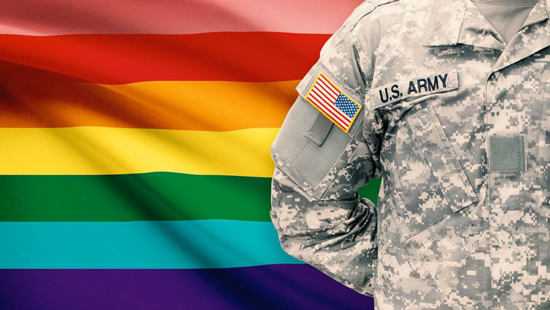the l effect | by morgan m. hurley –

This past September 20 marked the eighth anniversary of the day that the discriminatory policy known as “Don’t Ask, Don’t Tell” (DADT) was officially repealed, allowing gay, lesbian and bisexual people to serve openly. While this specific policy had been on the books for 17 years, discrimination toward gays, lesbians, bisexuals and transgender people in the military had been taking place for decades before that, and discharges were aggressively pursued.
The policy was originally called “Don’t Ask, Don’t Tell, Don’t Pursue,” but shortened for ease of use. Some who served on active duty prior to DADT, like me, initially felt it was a decent compromise, and here’s why:
Recruiters could no longer ask about a potential recruit’s sexual orientation on their intake forms; commanders and other leadership personnel within the service member’s chain of command could no longer ask those same questions, which were always posed with the sole intention of turning them over to authorities. On the flip side, service members were told not arbitrarily tell anyone in their working environment or chain of command that they were gay or lesbian.
The thinking was that as long as a service member served in silence (stayed in the proverbial closet), they could still serve. The biggest and most welcome change at the time was the end of the witch hunts; the Naval Investigation Service (NIS) was no longer tasked with randomly pursuing the existence of gays and lesbians in their midst.
Prior to DADT, the Department of Defense (DOD) spent millions of dollars, especially throughout the 1980s, tracking these service members down — most all with stellar records of service — to eradicate them from the military. Many went through court martials or non-judicial punishments (Captain’s Mast in the Navy, Office Hours or Article 15 hearings in other services) and often received “bad conduct,” “dishonorable,” or “other than honorable” discharges, depending on what angle NIS came up with. If they were lucky, they retained their honorable discharges, allowing them future veteran’s benefits.
– morgan m. hurley
“Fast forward exactly 17 years to December 22, 2010 — the day President Barack Obama signed the DADT repeal law into place — I was standing in the checkout line at a Macy’s department store and a friend texted me the news. Overwhelmed with emotion, I put my clothes down and went outside to cry.”
President Bill Clinton had made ending this ban one of his campaign promises in 1992 and it became his first order of business after he was elected. After a year of intense blowback from Republicans, Democrats, advisers and even folks in his own administration, Clinton felt that overall, DADT was a great compromise.
It was December 21, 1993 when he signed the DOD directive into place, so after three increasingly harrowing and intrusive investigations of my own in seven years, I thought it was an adequate transitional policy; of course, I never expected it to last as long as it did. Don’t get me wrong, people were still discharged; initially in record numbers, due to the complete lack of understanding of what was expected of those in charge.
Fast forward exactly 17 years to December 22, 2010 — the day President Barack Obama signed the DADT repeal law into place — I was standing in the checkout line at a Macy’s department store and a friend texted me the news. Overwhelmed with emotion, I put my clothes down and went outside to cry.
It would take seven more months of assimilation training before President Obama, Secretary of Defense Leon Panetta, and Chairman of the Joint Chiefs of Staff Admiral Mike Mullen sent the final certification to Congress on July 22, 2011, requesting the official repeal date of September 20. This whole process was done methodically by Obama, who as a constitutional lawyer, knew the steps required to make this ruling set in stone.
Within weeks of the repeal, San Diego activist Nicole Murray Ramirez reached out to two local veterans, Ben Dillingham and Bridget Wilson, each who had been giants in the fight for repeal. Ramirez told them he’d like to erect a wall at the San Diego LGBT Community Center to honor LGBT veterans who served and suffered under the stifling and discriminatory policies and then continued to go on and serve their LGBT communities.
The catch? He wanted to put their names on it. After some discussion, they agreed; and then things moved quickly.
On Thursday, November 10, 2011 (and every Thursday prior to Veterans Day thereafter), the Benjamin F. Dillingham, III and Bridget Wilson LGBT Veterans Wall of Honor held its first induction ceremony, with two selected as inaugural inductees in addition to the wall’s namesakes: Dillingham (USMC), Wilson (USNG) were joined by Jeri Dilno (USAF) and Jim Woodward (USN) on that groundbreaking day.
I joined the wall’s advisory committee after that inaugural year and have donated my time ever since. My experience of being betrayed by my shipmates and literally hunted by NIS — all despite my deep desire to do the very best for my country — stay with me to this day. This volunteer work gives me the continued opportunity to heal those wounds. The stories of each inductee are all unique and some are breathtaking. It is important to note that our trans brothers and sisters are still dealing with their own version of DADT today.
On Thursday, November 7 at 6:30 p.m. in The Center’s auditorium in Hillcrest, we will be honoring seven incredible veterans from that time who gave their all to their country and continued on giving their all to their LGBT community. We will also be honoring U.S. Rep. Susan Davis, who recently announced her retirement after this term. Davis was an instrumental ally in Congress during the fight for repeal.
I hope you will join us.